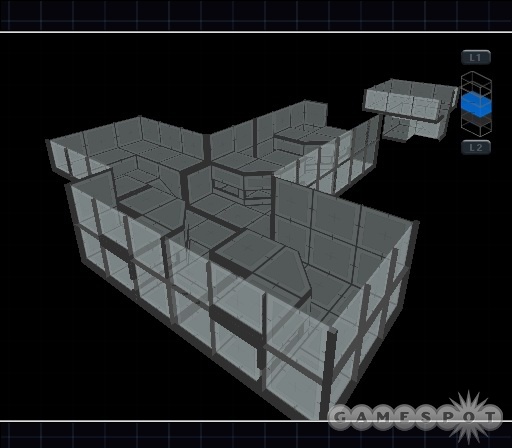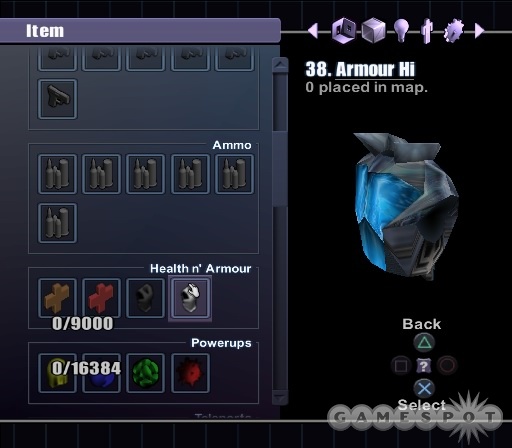TimeSplitters: Future Perfect Q&A - The Mapmaker
Free Radical bigwig David Doak answers our questions about the custom mapmaking interface in the upcoming shooter sequel.
Next month's TimeSplitters: Future Perfect will deliver everything fans of the longtime shooting extravaganza have come to expect--and then some. In addition to new maps, modes, weapons, and characters, Future Perfect will bring back one of the series' most unique features: a mapmaking interface that lets you construct your own arenas. Here to tell us how the new game's mapmaker will be significantly improved over the one found in TimeSplitters 2 is Free Radical director David Doak.
GameSpot: How pleased were you with how the mapmaker in TS2 worked out?

David Doak: We had big ambitions with the TimeSplitters 2 mapmaker. A major goal was to move it beyond being just a deathmatch level layout editor and to allow users to create simple gameplay and setups which were more like single-player challenges.
In the final TS2 version, we were very pleased with meeting the goal of bringing map creation with logic, objectives, and AI scripting to a console product, but probably a little disappointed with the usability. The TS2 mapmaker was a little too unforgiving in its presentation of the logic interface. I'm sure this put some people off, although we were very impressed to see the quality of maps that many users were creating.
What was particularly interesting was that, even without an official way to do it, many people were sharing maps online whether through pictorial instructions and plans or digitally through ripped saves via PCs. This was a clear confirmation of our belief that there was a receptive audience for an online mapmaker and sharing of user-created content.
GS: What did it lack that you addressed in Future Perfect?
DD: Aside from all of the online functionality and improvements to logic editing, which I've mentioned elsewhere here, we also took a long hard look at how the basic building blocks, the map tiles, fit together. Although both the TS1 and TS2 mapmakers had been very well received, we knew we could make the building part more flexible and make it easier for the user to create the kind of environment they wanted.
Universal connecting plugs on all tiles. Any tile can be connected to any other tile with no need for adaptor tiles.
More variety of tiles and mirroring of asymmetric tiles. Easier to find a tile to fit that space or refine the map layout.
Stackable tiles. Create holes in the floor and massive drops or camping spots for snipers.
Open maps with skies and weather. Maps don't have to be underground.
A bigger range of features and interactive items to populate the maps with.
Flexibility, variety, usability.
We've also incorporated technology features from the single-player and co-op story game in Future Perfect, most notably vehicles and a remote-controlled cat!
GS: How did the online functionality affect the development of the mapmaker? Did you have to rethink or redo anything?
DD: The problems are more to do with the real-world practicalities of dealing with content created by users. Our goal was to give people a tool which they could use to create exciting game content (multiplayer maps, single-player challenge levels, etc.) which could then be shared and modified.
Ultimately maps would evolve and improve. The possibilities are very exciting, and I think we are pioneering this work on consoles. I think a very exciting aspect of online gameplay is the extension of the interaction beyond simple competitive deathmatch-style gaming. Home-brew content creation and fan communities have been extremely important to the online PC gamers, and with the right software there is an enormous potential here for console gamers.
Unfortunately, console format holders can have some very strong opinions about how things should work, and, by default, commercial pressures may tend to restrict rather than encourage development of interesting functionality. It's a fiercely competitive business.
GS: Will the interface change, and if so, how?
DD: The interface has been completely revamped. For the general editing and building functions, this really just means clarification and trying to improve flow. For the logic side of things, it has been a very deep overhaul. As always, we can still see many things that could be further improved in the future, but I think that the TS:FP mapmaker is offering the most exciting and fully featured editor available on any console game.
People should look at it as a "make your own game" feature--it is that good.
GS: Has the map size been increased?
DD: Yes.
GS: Can you use your TS2 maps in Future Perfect?
DD: No. Backwards compatibility would have severely limited our plans for improving the mapmaker.

GS: Will there be any specific features for any of the platforms?
DD: No. Unless we have to take some out on particular versions because of format holder restrictions, then those features will become platform-specific value adders for the other versions.
GS: Thanks for your time.
Got a news tip or want to contact us directly? Email news@gamespot.com
Join the conversation